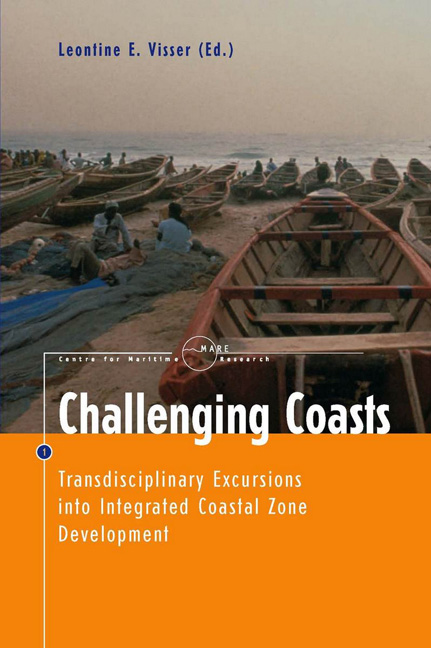Book contents
- Frontmatter
- Series Foreword
- Contents
- Acknowledgments
- 1 Introduction
- 2 Reflections on Transdisciplinarity, Integrated Coastal Development, and Governance
- 3 Biodiversity and the Natural Resource Management of Coral Reefs in Southeast Asia
- 4 A Concerted Approach towards Managing Living Resources in a Marine Protected Area
- 5 ‘Making Do’: Integrating Ecological and Societal Considerations for Marine Conservation in a Situation of Indigenous Resource Tenure
- 6 Basic Principles Underlying Research Projects on the Links between the Ecology and the Uses of Coral Reef Fishes in the Pacific
- 7 The Marine Implementation of the EC Birds and Habitats Directives: the Cases of Shipping and Oil Exploration Compared
- 8 Stakeholder Conflicts and Solutions across Political Scales: the Ibiraquera Lagoon, Brazil
- 9 ‘The Rich Eat Fish and the Poor Eat Pork’: The Decline of the Livelihoods of Handpickers of Aquatic Organisms in North Vietnam
- Index
- List of Contributors
3 - Biodiversity and the Natural Resource Management of Coral Reefs in Southeast Asia
Published online by Cambridge University Press: 28 January 2021
- Frontmatter
- Series Foreword
- Contents
- Acknowledgments
- 1 Introduction
- 2 Reflections on Transdisciplinarity, Integrated Coastal Development, and Governance
- 3 Biodiversity and the Natural Resource Management of Coral Reefs in Southeast Asia
- 4 A Concerted Approach towards Managing Living Resources in a Marine Protected Area
- 5 ‘Making Do’: Integrating Ecological and Societal Considerations for Marine Conservation in a Situation of Indigenous Resource Tenure
- 6 Basic Principles Underlying Research Projects on the Links between the Ecology and the Uses of Coral Reef Fishes in the Pacific
- 7 The Marine Implementation of the EC Birds and Habitats Directives: the Cases of Shipping and Oil Exploration Compared
- 8 Stakeholder Conflicts and Solutions across Political Scales: the Ibiraquera Lagoon, Brazil
- 9 ‘The Rich Eat Fish and the Poor Eat Pork’: The Decline of the Livelihoods of Handpickers of Aquatic Organisms in North Vietnam
- Index
- List of Contributors
Summary
Introduction
Biological diversity (or biodiversity) concerns the richness of life at three levels: genetic, species, and ecosystem (Norse 1993; Heywood 1995). These three aspects are interrelated, since an area with a high environmental variability most likely contains many species, and many species represent a high genetic variation. Within a species, isolated or distant populations may also show genetic diversity. Species richness is the most obvious form of biodiversity.
Concern with regard to the loss of global biodiversity has increased during recent decades (McNeely et al. 1990; Courrier 1992; Groombridge 1992; Dobson 1995; Heywood 1995). Few people realise that the seas and oceans contain more animal phyla and probably also more species than the land (Ray 1988; Grassle and Maciolek 1992; Briggs 1995; Williamson 1997). Perhaps this is why protection of marine biodiversity is several decades behind the conservation of terrestrial biodiversity (Thorne-Miller and Catena 1991; Norse 1993; Agardy 1994).
The present study introduces the centre of maximum marine biodiversity, which is predominantly determined by the abundant life on its coral reefs. The study identifies the major threats to the ecology of the area including, in particular, human exploitation of its living resources.
The Centre of Marine Biodiversity
Species of reef coral, mangrove, and seagrass are important for shaping and protecting sea shores. Their populations cover large portions of shallow sea bottom in the tropical coastal zone (Smith 1978; Burke et al. 2002). Coral reefs in the Indo-West Pacific constitute the richest shallow-water ecosystem of the world with many species of corals, sponges, molluscs, fishes, and other groups of animals (Spalding et al. 2001). More than mangrove woods and sea grass beds, coral reefs house many species of animals and plants that live together and depend on each other for survival. Therefore, coral reefs form the most important ecosystem in biodiversity studies, but they should not be considered the only important ecosystem since individuals of several species of animals start their lives inmangroves, live as juveniles in sea grass beds, and migrate to coral reefs as adults. Nevertheless, biodiversity is most obvious in coral reefs, and especially in the area with the highest concentration ofmarine species within the Indo-West Pacific, the eastern part of the Indo-Malayan region (Ekman 1953; Briggs 1974, 1995; Hoeksema 1992; Hoeksema and Putra 2002).
- Type
- Chapter
- Information
- Challenging CoastsTransdisciplinary Excursions into Integrated Coastal Zone Development, pp. 49 - 72Publisher: Amsterdam University PressPrint publication year: 2004
- 2
- Cited by



